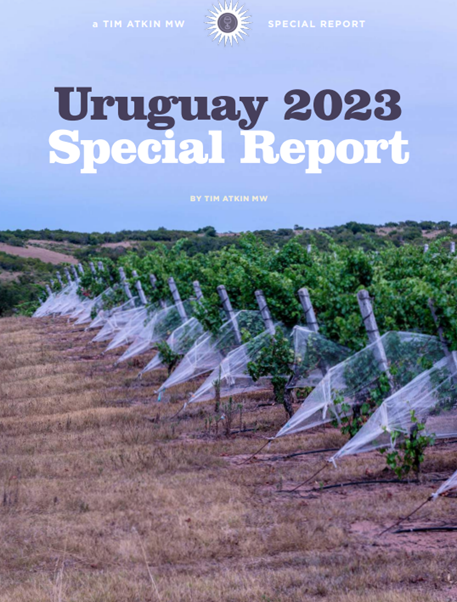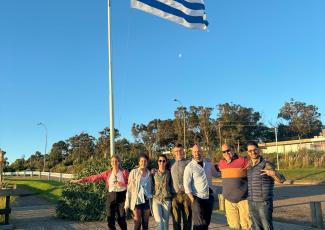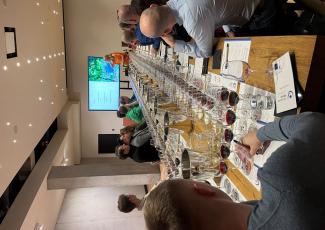
Uruguay Special Report 2023 - Tim Atkin
"Uruguay is better positioned than ever to make its mark."
Tim Atkin has done it again. The prestigious British Master of Wine visited Uruguay in January and, six months later, published a glowing report on Uruguayan wines. This time, in addition to assuring that Uruguay is making the best wines in its history, he warned that "we have not seen everything yet."
Dazzled by the new generation of winemakers, the critic spared no praise for local production. “It is both unique and singularly diverse. No other nation grows Arinnarnoa, Barbera, Marselan, Nebbiolo, Sangiovese, Tempranillo, and Zinfandel, as well as Southwestern French grapes like Cabernet Franc, Cabernet Sauvignon, Merlot, Petit Verdot, and, of course, Tannat. Once again, the quality of the best red wines was impressive, with a greater focus on terroir, as well as balance and harmony."
In Uruguay 2023 Special Report, Atkin also praises white wines, noting that “Uruguay continues to improve as a wine-producing nation. It's very different from its neighbors, Argentina and Brazil, and that's a good thing."
The critic talks to the world about Uruguay and structured his report into the 10 things you need to know about the country, among which is relevant information about our viticulture, highlighting the maritime influence and the characteristic humidity, in addition to the winds, “who are a constant company if you are visiting many of their vineyards”.
In turn, he expresses in the report the growing importance that the terroir is having for Uruguay and the extent of its harvest, which begins at the end of January and ends in mid-April.
One of the points is dedicated to Tannat, which Tim Atkin calls “the deserved flagship strain”. In this sense, the wonderful adaptation of the variety to the climatic conditions of Uruguay and the success it achieved in its vineyards stands out, "with greater humidity, maritime climate, with thick and protective skins, good structure and impressive aging potential." In addition, he highlighted the enormous variety that Tannat allows, thanks to the influence of its skin on the tannin concentration, the size of its leaf, which is almost double that of Cabernet Sauvignon, and its wonderful ability to mix with other strains. “Tannat is in the right place with the right viticulture and oenology and is capable of producing world-class wines.”
On the other hand, the report ensures that Uruguayan viticulture is more diverse than you think. Because clearly, Uruguay is not just Tannat, “but its diversity represents the contrasting and sometimes competitive demands of the national and international markets. There are reminders of the past, the presence of table grapes and hybrids on the list, as well as encouraging signs of people looking to the future,” he notes.
Regarding the white wines, he stated that many of them are almost as good as the reds, “especially those made from Albariño, a grape that was not planted here until 2001. The best ones are just as exciting as those from Rías Baixas in Spain”. In this sense, the critic collects the testimony of INAVI's technical adviser, Ing. Agr. Eduardo Félix, who states that "Albariño is fast becoming Uruguay's iconic white grape, perfectly at home in our Atlantic climate."
In the penultimate point of his decalogue, the critic warns of the foreign influence on the quality of Uruguayan wines, comparing the legacy of immigrants from the old world as pioneers of Uruguayan viticulture, with the more recent contribution of new experts who arrived to promote the natural virtues of Uruguay and its wines.
Arriving at point 10, MW Tim Atkin wonders about the future and answers: "The most immediate task is to talk to more people about Uruguayan wine and put a glass in their hands." Furthermore, he said, consumer trends are playing in favor of Uruguay. “Freshness and finesse, the same things that possess the best Uruguayan wines, are increasingly in fashion. And even if the vintages are getting warmer and earlier due to climate change, that's still the case. Maldonado is not Mendoza; Tannat is not Malbec. Volumes and economies of scale are not there to conquer the world, but Uruguay is better positioned than ever to make its mark."
The podium according to MW Tim Atkin
Winemaker of the Year: Pablo Fallabrino, Bodega Pablo Fallabrino
Young Winemaker of the Year: Martín Viggiano, Bodega Cerro del Toro
Winemaker legend: Laura Casella, Antigua Bodega
Winegrower of the Year: Gustavo Blumetto, Familia Deicas Winery
Red Wine of the Year: 2020 Bodega Garzón Balasto, Maldonado
White Wine of the Year: 2020 Familia Deicas Albariño Cru d'Exception, Maldonado
Rosé Wine of the Year: 2022 Bodega Oceánica José Ignacio Pinot Noir Rosé, Maldonado
Sparkling Wine of the Year: 2020 Viña Edén Pueblo Edén Brut, Maldonado
Red wine discovery of the year: 2021 Cerro del Toro Tannat Rocamadre, Piriápolis
White wine discovery of the year: 2021 Compañía Uruguaya de Vinos de Mar Ter Admirabilis Albariño, Maldonado
Value red wine of the year: 2021 Giménez Méndez Cómplice Tannat, Canelones
Value White Wine of the Year: 2022 Marichal Sauvignon Blanc, Canelones
Value rosé wine of the year: 2022 Juanicó Don Pascual Coastal Rosé,
Value Sparkling Wine of the Year: 2022 Viña Progreso Underground Pet Nat Torrontés, Canelones


